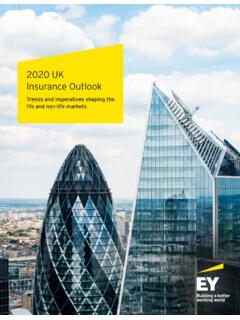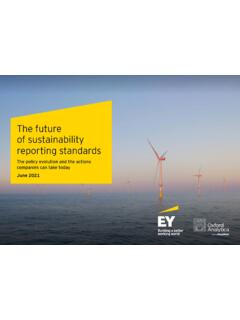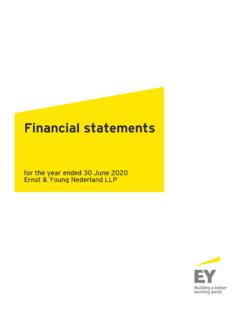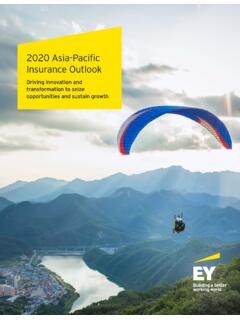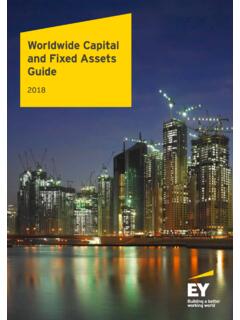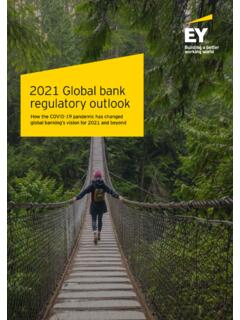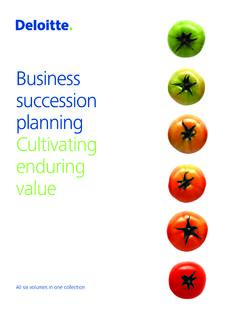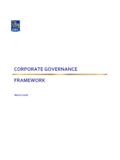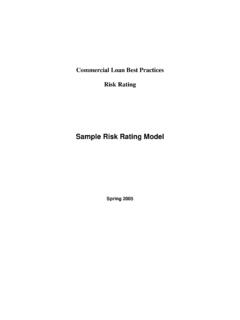Transcription of Six priorities for boards in 2021 (pdf) - EY
1 EY Center for Board MattersSix priorities for boards in 2021 Following a year of global upheaval, organizations are re-evaluating every aspect of their business. In 2021, companies and boards will face an acceleration of existing challenges and be compelled to address how they are building resilience and creating sustainable value in a rapidly changing business environment. With increased investor scrutiny and stakeholder considerations, boards will be well served to focus on the following priorities in 2021: Overseeing strategy to create long-term value Promoting enterprise resiliency in the face of uncertainty Focusing on workforce transformation and new ways of working Leading on diversity, equity and inclusion Guiding an ESG strategy that drives stakeholder engagement and value Challenging board composition and effectivenessSix priorities for boards in 20214 Overseeing strategy to create long-term valueBoard priority for 2021 Six priorities for boards in 20215 Leading boards are working with management teams to oversee a strategy formulation process that drives long-term value a difficult task made more complex by the need to solve for the now, explore the next and reimagine the world beyond 2020.
2 In today s stakeholder-focused business environment, it is imperative that companies define both financial and nonfinancial value drivers and include them in strategy-setting as they consider the needs of investors, employees, consumers, society and other key stakeholders. Longer-term assumptions within the strategy should be developed using internal and external sources of information on megatrends, investment flows by venture capital and private equity entities, along with monitoring merger and acquisition, alliance and joint venture activity. Traditional sector and adjacent construct analyses along with external risk intelligence can provide early indicators of emerging opportunities and risks. An analysis of the full potential of the company s existing business model(s) and weaknesses can determine the need and timing of strategic pivots.
3 Indeed, during 2020, winners were able to quickly adjust their business models to meet new stakeholder needs ( , work from anywhere, food/supply delivery and pickup, telemedicine and digital offerings). The strategy should be inclusive of investments in strategic competencies to meet material stakeholder needs and future expectations, including those related to environmental, social and governance (ESG) matters. Once the strategy is refreshed, it is critical for the board and leadership team to consider operating model changes including culture and employee behavior requirements to confirm alignment with the organization s purpose, vision and strategy. Finding ways to foster innovation broadly through a company s culture can enhance strategy and thus growth for the long term. Management should integrate strategy and culture with the company s enterprise risk management process and provide the board with timely updates related to strategic opportunities and risks.
4 This was a focus of the Committee of Sponsoring Organizations update of its risk management framework the first two components of which are governance and culture; and strategy and objective-setting indicating the importance of monitoring these topics for risk mitigation. Finally, the board and management should collectively challenge whether they have the appropriate governance processes to enable the timely review and implementation of a robust strategy across the short-mid-, and long-term time horizons. A long-term value dashboard that includes metrics to gauge financial, human, consumer and societal value should be reviewed regularly by the board and monitored by management to ensure metric credibility. Board time should also be evaluated along with the potential use of a committee or an ad hoc committee given the need to continuously review strategic assumptions over a longer term.
5 Key actions for directors to take in 2021 Balance the board s oversight of strategy and investments over the short, medium and longer terms to sustain long-term value. Obtain an appropriate mix of internal and external data and information to validate key assumptions and determine strategic pivots. Integrate ESG opportunities and risks into strategy frameworks and decisions. As strategy shifts, evaluate that the culture has been redefined to incorporate new behaviors required to drive the strategy over the long term. Create a long-term value dashboard with regular briefings to the board to ensure shareholder value improvement manifests from a balanced focus on financial, human, consumer and societal value enterprise resiliency in the face of uncertaintyBoard priority for 2021 Six priorities for boards in 20217 Board members are playing a pivotal role in helping management adapt their organizations to the world beyond the pandemic and overseeing how resiliency is built into all aspects of the business.
6 The foundation of this work includes board oversight of updates to scenario plans, stress testing and contingency planning that critically emphasize key assumptions and variables across a range of extreme on the outcomes of these scenario plans and stress tests, organizations are assessing liquidity needs and shoring up financial stability, strengthening supply chains (through resilience assessments and networked ecosystems with end-to-end visibility) and enabling greater flexibility in operating models. A physical return-to-work scenario will call for continued focus on employee health and well-being and building trust in safety protocols and monitoring. This may require new or enhanced health and safety capabilities such as testing, certification, contact tracing and vaccination. Additionally, capacity planning and changes to workspace configurations are prompting a re-evaluation of companies geographical footprint and related real estate needs.
7 Successful companies will adopt agile approaches to navigating the rapidly shifting business environment at the management level and in the boardroom. boards will need to proactively anticipate change and address the risks and opportunities associated with key trends shaping the current and future business context. Some, like digital transformation, future of work and exponential climate impacts, have been accelerating and are already disrupting business models and strategy in the near term. These factors are also contributing to a shifting risk landscape, risk profile and risk appetite (including upside risks that will drive growth and value). Adding to this are risks associated with increased cybersecurity and privacy issues related to digital transformation and remote work, rising geopolitical risks and the changing regulatory environment, with governments likely to be more active in the economy for the foreseeable future.
8 Adapting enterprise risk management (ERM) processes and controls to be more responsive to change will help enable strategic pivots and build enterprise resilience. This includes assessing how the three lines model is being effectuated and discussing with management ways to optimize the model so that it is efficient and fit for purpose. To help their organizations reimagine enterprise resilience and seize the upside of accelerating risks, boards should confirm management s use of data-driven intelligence from a wide range of sources, its management of risk aggregation and interdependencies across the value chain and the execution of regular postmortems to incorporate key actions for directors to take in 2021 Set aside more time on board agendas to challenge assumptions, review contingency plans and verify that management is incorporating low-risk/high-impact scenarios into its ERM frameworks and strategy.
9 Analyze megatrends and identify key management and external advisors to regularly report to the board on material business environment developments and data points to continuously improve oversight of strategy and risk. Turn emerging risks into strategic value by taking a balanced approach to risk management across the three dimensions of risk: downside, upside and outside, with a greater focus on upside and outside risks. Review key performance indicators developed by management to measure key risks and opportunities and assess the value of material intangible assets such as human capital and culture. Re-evaluate risk oversight practices and related structures to assess whether board or committee oversight changes would enhance oversight. Review management s conclusions and effectiveness following postmortems regarding corporate responses to the pandemic, social justice movements and other material economic and business impacts in 2020.
10 8 Focusing on workforce transformation and new ways of workingBoard priority for 2021 Six priorities for boards in 20219 Historically, many boards limited their talent oversight responsibilities to C-suite succession planning and development. Today s leading boards recognize human capital as a key driver of long-term value. The remit of the board regarding human capital will continue to broaden throughout 2021. They also recognize that recent trends including five generations moving through the workforce, digitalization, virtual work and automation are redefining ways of working. The pandemic has accelerated this transformation and highlighted workforce management as a fundamental part of strategy that boards must oversee. Companies are adapting to a new environment in which human health and wellness have taken a central role in operations.
